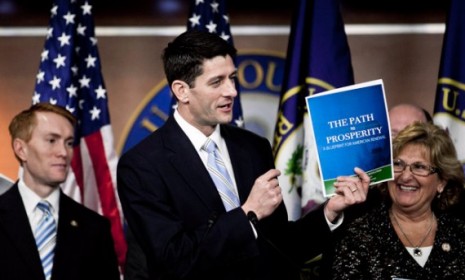Paul Ryan's budget: 4 ways it proves he's not a fiscal mastermind
Mitt Romney's running mate has a reputation as a serious policy intellectual, but critics say his budget is just fuzzy math and magical thinking

Paul Ryan, Mitt Romney's running mate, is often characterized as the "Wonk King of the Republicans" — an expert on fiscal policy who enjoys perusing CBO budget estimates in his free time. The Wisconsin Republican's budget, titled "The Path to Prosperity," has been praised for its unflinching proposals to steer America away from a deficit abyss, particularly via a radical overhaul of Medicare and Medicaid. Ryan's critics, however, see the congressman as a salesman who has assiduously cultivated an image as a sensible wonk, but is really an ideological crusader using the aura of accounting to mask his tax cuts for the rich and spending cuts for the poor. Paul Krugman, the Nobel-winning economist and liberal stalwart, says Ryan merely "scribbled some stuff down, without checking at all to see if it makes sense," while David Stockman, Ronald Reagan's budget director, says Ryan's plan is a fairy tale "devoid of credible math." Here, four ways Ryan's budget prove he's not the wonky fiscal mastermind he purports to be:
1. Ryan's numbers don't add up
Ryan's budget calls for major tax cuts for corporations and the wealthy that would cost $4.3 trillion over the next 10 years, according to the nonpartisan Tax Policy Center. But Ryan hasn't fully explained how he would make up for that lost revenue. His proposed cuts to entitlement programs would free up only $1.7 trillion: $700 billion from Medicare savings in President Obama's health care overhaul, and billions more from slashing food stamps and health insurance for the poor and disabled. Ryan claims he would also eliminate certain tax benefits and deductions, many of which are very popular with middle- and lower-income families, but hasn't specified which ones. He says he will further cut spending, but hasn't detailed how.
The Week
Escape your echo chamber. Get the facts behind the news, plus analysis from multiple perspectives.

Sign up for The Week's Free Newsletters
From our morning news briefing to a weekly Good News Newsletter, get the best of The Week delivered directly to your inbox.
From our morning news briefing to a weekly Good News Newsletter, get the best of The Week delivered directly to your inbox.
2. His budget would balloon the national debt
Without explaining where the money would come from, Ryan somewhat implausibly claims government revenue would climb to 19 percent of GDP by 2028, up from 15 percent in 2010. And even if we were to take Ryan at his word, his plan would still not balance the budget "until the 2030s, while adding $14 trillion in debt," says Matt Miller at The Washington Post. His plan would add $6 trillion in debt "over the next decade alone," requiring yet another hike to the national debt ceiling — even though Republicans have strenuously opposed such moves under Obama.
3. He's performing some Medicare magic
Ryan has proposed transforming Medicare into a voucher program, giving elderly citizens a choice to either purchase traditional Medicare coverage or private insurance. Ryan claims that the move would bring federal health spending down to 4.75 percent of GDP in 2050, down from 5.5 percent in 2010. "If you believe that is likely," says Martin Wolf at The Financial Times, "I have a bridge to sell you." The problem is that Medicare enrollment is set to swell dramatically as more Baby Boomers retire. In addition, there is no evidence seniors will opt for private insurance — after all, the rising cost of private insurance has been a problem for decades.
A free daily email with the biggest news stories of the day – and the best features from TheWeek.com
4. He hopes to shrink the government to an unrealistic degree
Ryan projects that his budget will eventually reduce federal spending to 14.25 percent of GDP by 2050, down from 22.5 percent in 2010. However, to reach that number, all spending besides health care, national security, and interest rate payments would have to be reduced to 3.5 percent of GDP; this 3.5 percent would have to cover expenditures for education, scientific research and development, national parks, farm aid, veterans' benefits, small-business loans, infrastructure, and much more. The U.S. has spent at least 8 percent of GDP on these categories every year since World War II, says the Congressional Budget Office. Critics say such a goal is wildly unrealistic.
Sources: The Financial Times, New York, The New York Times (2) (3), The Washington Post
Read more political coverage at The Week's 2012 Election Center.
-
 Political cartoons for December 7
Political cartoons for December 7Cartoons Sunday’s political cartoons include the Trump-tanic, AI Santa, and the search for a moderate Republican
-
 Trump’s poll collapse: can he stop the slide?
Trump’s poll collapse: can he stop the slide?Talking Point President who promised to ease cost-of-living has found that US economic woes can’t be solved ‘via executive fiat’
-
 Sudoku hard: December 7, 2025
Sudoku hard: December 7, 2025The daily hard sudoku puzzle from The Week
-
 Has Zohran Mamdani shown the Democrats how to win again?
Has Zohran Mamdani shown the Democrats how to win again?Today’s Big Question New York City mayoral election touted as victory for left-wing populists but moderate centrist wins elsewhere present more complex path for Democratic Party
-
 Millions turn out for anti-Trump ‘No Kings’ rallies
Millions turn out for anti-Trump ‘No Kings’ ralliesSpeed Read An estimated 7 million people participated, 2 million more than at the first ‘No Kings’ protest in June
-
 Ghislaine Maxwell: angling for a Trump pardon
Ghislaine Maxwell: angling for a Trump pardonTalking Point Convicted sex trafficker's testimony could shed new light on president's links to Jeffrey Epstein
-
 The last words and final moments of 40 presidents
The last words and final moments of 40 presidentsThe Explainer Some are eloquent quotes worthy of the holders of the highest office in the nation, and others... aren't
-
 The JFK files: the truth at last?
The JFK files: the truth at last?In The Spotlight More than 64,000 previously classified documents relating the 1963 assassination of John F. Kennedy have been released by the Trump administration
-
 'Seriously, not literally': how should the world take Donald Trump?
'Seriously, not literally': how should the world take Donald Trump?Today's big question White House rhetoric and reality look likely to become increasingly blurred
-
 Will Trump's 'madman' strategy pay off?
Will Trump's 'madman' strategy pay off?Today's Big Question Incoming US president likes to seem unpredictable but, this time round, world leaders could be wise to his playbook
-
 Democrats vs. Republicans: who are US billionaires backing?
Democrats vs. Republicans: who are US billionaires backing?The Explainer Younger tech titans join 'boys' club throwing money and support' behind President Trump, while older plutocrats quietly rebuke new administration